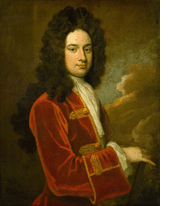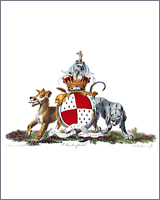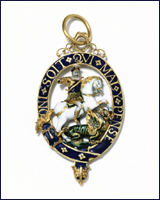James, 1st Earl of Stanhope…
 James Stanhope (1673-1721) was born in Paris, the eldest of the seven children of Alexander Stanhope (1638-1707), and his wife Katherine (d. 1718), the daughter and co-heir of Arnold Burghill of Thinghall Parva, Withington, Herefordshire, by his second wife Grizell, co-heir of John Prise of Ocle Pyrchard, Herefordshire. He was educated at Eton College and at Trinity College, Oxford, where he matriculated in May 1688.
James Stanhope (1673-1721) was born in Paris, the eldest of the seven children of Alexander Stanhope (1638-1707), and his wife Katherine (d. 1718), the daughter and co-heir of Arnold Burghill of Thinghall Parva, Withington, Herefordshire, by his second wife Grizell, co-heir of John Prise of Ocle Pyrchard, Herefordshire. He was educated at Eton College and at Trinity College, Oxford, where he matriculated in May 1688.
James accompanied his father, then British minister at Madrid, to Spain in 1690, and obtained some knowledge of that country which was very useful to him in later life. A little later however, he went to Italy where he served as a volunteer against France, and in 1695 he secured a commission in the British army.
In 1701 James entered the House of Commons, but he continued his career as a soldier and was in Spain and Portugal during the earlier stages of the War of the Spanish Succession. In 1705 he served in Spain under Charles Mordaunt (1658-1735), 3rd Earl of Peterborough, and in 1706 was appointed British minister in Spain, but his duties were still military as well as diplomatic, and in 1708, after some differences with Peterborough, who favoured defensive measures only, he was made commander-in-chief of the British forces in that country.
Taking the offensive he captured Port Mahon, Minorca, and after a visit to England, where he took part in the impeachment of Sacheverell, he returned to Spain and in 1710 helped to win the battles of Almenar and of Saragossa, his perseverance enabling the Archduke Charles to enter Madrid in September. However, at Brihuega he was overwhelmed by the French and was forced to capitulate on 9 December 1710. He remained a prisoner in Spain for over a year and returned to England in August 1712.
On 24 February 1713, Stanhope married Lucy Pitt (1692-1723), a younger daughter of Thomas Pitt, governor of Madras. Although in future years Stanhope found little time for domesticity, it was a happy union, and the couple had seven children, including two sets of twins.
He now abandoned the army for politics, and became one of the leaders of the Whig opposition in the House of Commons. He had his share in establishing the House of Hanover on the throne, and in September 1714 was appointed Secretary of State for the Southern Department, sharing with Walpole the leadership of the House of Commons. He was mainly responsible for the measures which were instrumental in crushing the Jacobite Rising of 1715, and he forwarded the passing of the Septennial Act. He acted as George Iís foreign minister, and only just failed to conclude a treaty of alliance with France in 1716. In 1717 James was made First Lord of the Treasury, but returned a year later to his former office of secretary for the southern department.
In 1717 he was also created Viscount Stanhope of Mahon and later in 1718 Earl of Stanhope. James was in all but name Prime Minister. His activity was now shown in the conclusion of the Quadruple Alliance between England, France, Austria and the United Provinces in 1718, and in obtaining peace for Sweden, when threatened by Russia and Denmark, while at home he promoted the bill to limit the membership of the House of Lords. Just after the collapse of the South Sea Bubble, for which he was partly responsible but from which he did not profit, the Earl was defending his government with customary vigour and panache in the House of Lords on 4 February 1721 when he was taken ill with a violent headache. After some apparent recovery the following day, he died of a stroke at eight o'clock that evening.
The king was shocked and distraught at the sudden 'loss of so able and faithful a minister, of whose service his Majesty had so great need at this critical juncture'. On the king's orders James Stanhope was given a full military funeral through London on 17 February to Southwark, and later privately buried at Chevening. He was succeeded by his eldest son Philip (1714-1786), a distinguished mathematician and a fellow of the Royal Society.


